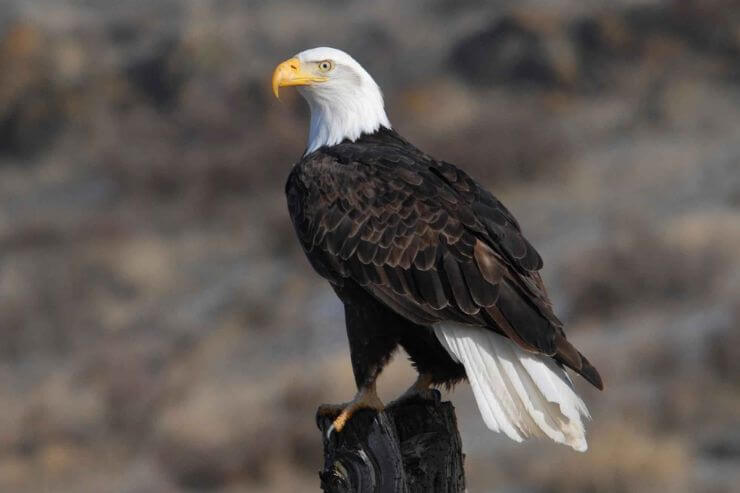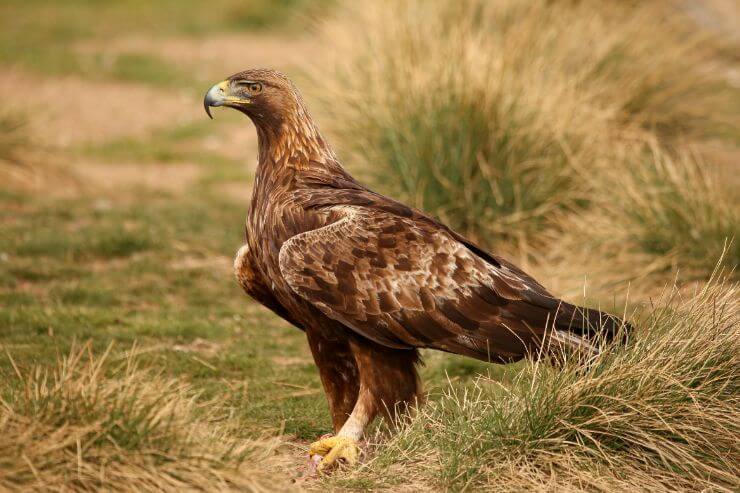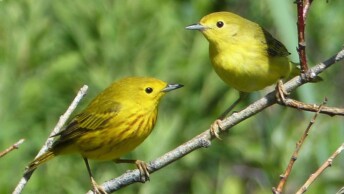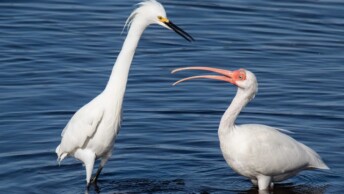Louisiana’s expansive wetlands and lush landscapes create an ideal environment for eagles, making it a captivating destination for bird enthusiasts. The Bald Eagle, with its iconic white head and powerful wingspan, graces the skies, symbolizing both majesty and wilderness. Observing these eagles in their natural habitat is a thrilling experience, combining the awe of wildlife watching with the serene beauty of Louisiana’s outdoors.
Eagles in Louisiana are a testament to the state’s rich biodiversity. These raptors not only captivate with their grace and power but also play a vital role in the ecosystem, helping to maintain a healthy balance. From their commanding presence in the sky to their intricate nesting behaviors, eagles add an extraordinary element to Louisiana’s natural scenery.
Engaging with these magnificent birds offers a deep connection to nature, revealing the delicate balance of the ecosystems they inhabit. Whether soaring high above the bayous or perched regally on tree branches, Louisiana’s eagles inspire both admiration and respect.
Their presence highlights the importance of conservation efforts to ensure that future generations can experience the wonder of these incredible raptors in the wild, maintaining the state’s ecological richness and natural heritage.
Bald Eagle
- Scientific name: Haliaeetus leucocephalus
- Life span: 20-30 years
- Size: 2.5 to 3 feet (0.7 to 0.9 meters)
- Weight: 6.6 to 13,8 lbs (3 to 6.3 kg)
- Wingspan: 66 to 96 in (165 to 244 cm)
- Status: Least Concern
- State status: Breeding and common
The Bald Eagle, the national bird and symbol of the United States, is a magnificent sight across much of North America, including Louisiana. This iconic bird is easily recognizable by its white head and tail, contrasting sharply with its dark brown body and wings. The beak, eyes, and feet of the Bald Eagle are a vivid yellow, adding to its striking appearance.

Juvenile Bald Eagles, however, lack this distinct plumage, being mostly brown with mottled white until they mature at around five years of age. In Louisiana, Bald Eagles are a more common sight, particularly around large bodies of water like lakes, rivers, and coastal areas where they nest and fish. The state’s abundant wetlands provide ideal habitats for these eagles to thrive.
Watching a Bald Eagle soar with its broad, flat wings held straight out is a breathtaking experience. Their impressive nests, often reused and added to each year, can be found high in large trees, and are a testament to their strong presence in the region. Conservation efforts have helped Bald Eagle populations recover from historical declines, making them a more frequent and celebrated sight in Louisiana’s skies.
Bald Eagles are known for their impressive nesting behavior, constructing some of the largest nests of any bird species. These raptors prefer to nest in tall, sturdy trees near large bodies of water, which provide ample hunting opportunities.
The nests, or eyries, are massive structures built from sticks, lined with softer materials like grass, moss, and feathers. Both the male and female participate in building the nest, a process that can take up to three months. Over the years, these nests can become enormous, reaching up to 13 feet deep and 8 feet wide, as eagles often return to and add to the same nest annually. In Louisiana, Bald Eagles typically begin nesting in late fall, with the female laying 1-3 eggs.
The incubation period lasts about 35 days, during which both parents share the responsibility. Once hatched, the eaglets remain in the nest for about 10-12 weeks, during which time they are cared for and fed by both parents until they fledge.
The diet of Bald Eagles is diverse, but they primarily feed on fish, which they catch with their powerful talons. Their hunting technique is spectacular to watch; they soar high above the water, spot their prey with their keen eyesight, and then dive down at incredible speeds to snatch fish from the water’s surface. In Louisiana, abundant waterways provide a rich supply of fish, making it an ideal habitat for these raptors.

Besides fish, Bald Eagles also hunt small mammals, birds, and occasionally scavenge carrion. They are opportunistic feeders and will sometimes steal food from other birds, such as ospreys. This behavior, known as kleptoparasitism, highlights their adaptability and resourcefulness in securing food. During the winter, when fish are less accessible, they rely more on scavenging, making use of dead animals found along the shores and in the fields.
The conservation history of the Bald Eagle is a remarkable success story. By the mid-20th century, Bald Eagle populations had plummeted due to habitat destruction, hunting, and, most significantly, the widespread use of DDT, a pesticide that weakened their eggshells. Recognizing the severity of the decline, conservationists and government agencies took decisive action.
The Bald Eagle was listed as an endangered species in 1967, and the banning of DDT in 1972 marked a turning point. Intensive conservation efforts included habitat protection, legal protection from hunting, and programs to reintroduce eagles to areas where they had disappeared. In Louisiana, these efforts have paid off tremendously. The state’s extensive wetland restoration projects and strict enforcement of protective laws have helped create a thriving environment for Bald Eagles.
Today, Bald Eagles are no longer endangered, and their populations have rebounded significantly, making them a symbol of successful wildlife conservation.
Golden Eagle
- Scientific name: Aquila chrysaetos
- Life span: 30 years
- Size: 26 to 40 inches (66 to 102 cm)
- Weight: 6.4 to 13.2 lb (2.9 to 6 kg)
- Wingspan: 70 to 90 in (180 to 230 cm)
- Status: Least Concern
- State status: Migratory and rare
The Golden Eagle, one of North America’s most formidable birds of prey, boasts a wide geographical range that spans from Alaska and Canada down through the United States, including rare visits to Louisiana.
This majestic raptor is known for its powerful build and striking appearance. It has a dark brown body with a golden sheen on the back of its head and neck, which glows brilliantly in the sunlight, giving the bird its name. The wings are long and broad, often appearing slightly bent when soaring high in the sky. Adult Golden Eagles have distinct yellow legs and feet, adorned with sharp talons that are formidable tools for hunting. Their eyes are a piercing dark brown, set in a fierce expression that commands respect. Immature eagles can be identified by the white patches at the base of their tail and wings, which they lose as they mature.

Though sightings in Louisiana are rare and usually confined to the winter months, the Golden Eagle’s majestic presence is always a memorable highlight for bird watchers fortunate enough to spot this elusive raptor. It’s a bird that has been coming back in my home country of Denmark the last couple of years, so I always try to go see it when it’s around.
Golden Eagles, though rare in Louisiana, exhibit fascinating nesting behaviors that reflect their adaptability and resilience. These eagles prefer open, mountainous, or hilly terrains, where they build their nests on cliffs or in tall, isolated trees. The nests, called eyries, are constructed from sticks and lined with softer materials such as grass, moss, and leaves.
A single pair of Golden Eagles may use the same nest site for many years, adding new materials each breeding season, which results in large, sturdy nests. In areas where cliffs are scarce, such as parts of Louisiana, they may nest in tall trees, adapting to the local landscape. The female lays 1-3 eggs, and both parents take turns incubating them over about 45 days.
Once hatched, the eaglets are cared for diligently by both parents, remaining in the nest for about 10-12 weeks before fledging. This extended period of parental care ensures that the young eagles develop the necessary skills for survival.
Golden Eagles are formidable hunters with a diverse diet that primarily consists of small to medium-sized mammals. They are known for their ability to hunt rabbits, hares, ground squirrels, and even larger prey like foxes and young deer. Their powerful talons and keen eyesight make them highly effective predators.
In addition to mammals, Golden Eagles also hunt birds and reptiles, showcasing their versatility as hunters. They are capable of remarkable aerial agility, allowing them to capture birds in flight. Golden Eagles are also known to scavenge carrion, especially during the winter months when live prey is scarce.

This adaptability in their diet allows them to thrive in a variety of habitats, from the rugged mountains of the West to the open fields and forests of Louisiana. Despite their rarity in the state, the presence of suitable prey species can occasionally attract Golden Eagles during their migratory movements.
The conservation history of the Golden Eagle is less dramatic than that of the Bald Eagle but equally important. Golden Eagles have faced threats from habitat destruction, illegal shooting, and poisoning from rodenticides and lead ammunition. Conservation efforts for Golden Eagles have focused on protecting their habitats and reducing human-induced mortality.
In the United States, they are protected under the Bald and Golden Eagle Protection Act, which prohibits the killing, selling, or possessing of these birds. Additionally, efforts to reduce the use of lead ammunition and promote lead-free alternatives have been crucial in preventing lead poisoning in Golden Eagles.
In Louisiana, conservation efforts include monitoring their population during the winter months and ensuring that their habitats are protected. Public education campaigns also play a vital role in promoting awareness about the importance of conserving Golden Eagles and their habitats. These efforts are essential to maintaining healthy populations of this majestic raptor, ensuring that they continue to soar across the skies of North America.
Where to find Eagles in Louisiana
Louisiana’s diverse landscapes and waterways create ideal habitats for eagles, making it a fantastic state for birdwatching. To spot these magnificent birds, venture out early in the morning or late in the afternoon when they are most active. Equip yourself with binoculars, a field guide, and a bit of patience to enhance your eagle-watching experience.
Four excellent areas to find eagles in Louisiana include the Atchafalaya Basin, a vast swampy area rich in wildlife. Here, the combination of dense forests and open water provides perfect nesting sites and hunting grounds for eagles. Another great spot is Catahoula Lake, known for its significant eagle population during migration periods. This area offers expansive views and plenty of opportunities to see eagles soaring above.
Grand Isle, a barrier island, also offers excellent eagle-watching opportunities. The island’s unique ecosystem attracts a variety of bird species, including eagles, making it a must-visit for bird enthusiasts. Lastly, Lake Pontchartrain, with its large surface area and surrounding wetlands, provides a perfect habitat for eagles. The lake’s serene environment allows for peaceful observation of these majestic birds as they hunt and nest.
By visiting these locations and taking the time to explore Louisiana’s natural beauty, you’ll be rewarded with unforgettable sightings of eagles in their natural habitats, adding a touch of wild majesty to your outdoor adventures.
Conclusion
Louisiana’s diverse landscapes provide an ideal habitat for both Bald Eagles and the rarer Golden Eagles. The state’s commitment to conservation has allowed these majestic birds to thrive, offering birdwatchers and nature enthusiasts an opportunity to witness their grandeur.
By protecting their habitats and supporting conservation efforts, we can ensure that eagles remain a vibrant part of Louisiana’s natural heritage for future generations to enjoy.



